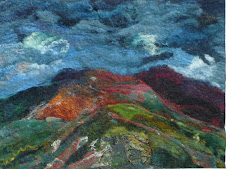I am doing too much.
These are all the things I am doing if I list them I might be able to see what can be dropped. I feel that if I was doing Master Chef ( if you are not in the UK and reading this just don't ask it is too complicated!) I would be told to focus and that dyeing does not get harder than this!
Okay
Projects on the go I am enjoying doing.
Inks-on the back burner at the moment but I had a big read of David Carvalho (40 centuries of ink) while waiting for a friend to get through her physiotherapy. I have taken notes and which need to be transcribed onto the computer as they are in two different if not three notebooks, I now want to try the recipe for black ink that includes logwood.
Fermenting Dyes and slow dyeing
I really enjoy doing this as it is:
a. Possible to leave stuff fermenting for days on my hotplates
b. It is really ecofriendly
c. It appeals to my desire to experiment
d. I want to write a booklet about it
e. Most importantly the colours seem so rich
Natural Dyeing using the extract dyes
I was one of the first people in the UK to use these and one of the few as a far as I aware who uses them to paint fibres and fabrics. However there are plenty of people who are using them now and I want to keep abreast of it all. I want to write a booklet on this as a part of the series ( Colours of the Earth, Colour of the Sea and Sky being the other two)
I am trying out all sorts of mixtures and it is the keeping of records and photographing the results that takes time however when I wrote the indigo book last year I had a wonderful time really enjoyed myself but it did take about three months of fairly intensive work. It was just after my father died and because I had been looking after him I did not have much work it only really picked up in April & May.
School Projects However I now have two school projects one on Celtic brooches/celtic inspired pencil cases. and one a community project both a week long. I can 't drop these and am committed to them and I need to start ordering fibres and making samples. On is in March one in April
What else- well a one day workshop with kids dyeing fibres and making celtic brooches in March, A brand new workshop Felt Sketchbooks in May for which I need to do some more work, getting a stall ready for the Regional day at Liverpool being run by Embroiderers in April and also the two day event Wonderwool at the end of April for which I not only need to make up packs and kit but also all the associated stuff-leaflets etc.
As I write this I start to feel quite panicky ! I am not sure that I have done much more than freak myself out and I either cannot drop a anything or don't want too!
Oh well!
Enys dropped off the list of seeds she has ordered for the dye garden. Fortunately all I have to do is read the list and make admiring noises.
Baptisia australis
Dyers camomile
Podophyllum
Asceplias Tuberosa - don't ask! I can't find this in my dye books but Enys says that her herbal books say this is a dye plant.
Weld
madder
Coreopis
calliopsis
Indigofera
Asarum Europ
Woad
Genista Tinctoria
Black pansies - I grew these last year ( well Enys grows them I just use them!)as a friend Annee Silk told me about them. They give a beautiful fabulous rich blue colour but not very lightfast but I want to try again and weather permitting try solar dyeing with them.
Annee has already sent me chinese woad
Incidentally my genista is coming into flower. Ilove Genista Tinctoria- this last two years it has given a fabulous colour as strong as weld but I have now used all of last years.
And today I dyed with this years new season of woad leaves and got a pale blue with two good handful of leaves and on about 25g of wool tops. see ! I should have been doing boring stuff like my accounts but I could not help trying out the leaves to see whether they would give a decent colour this early in the year.
Inadvertently Monochromatic Photos
-
Recently it's felt both busy and so slow! We've had snow squalls and
storms arriving early this year. We've had Alberta Clippers coming in off
the lak...
5 days ago



































